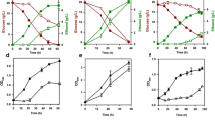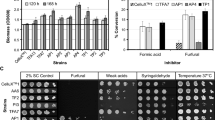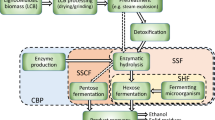Abstract
We have previously developed a dynamic flux balance analysis of Saccharomyces cerevisiae for elucidation of genome-wide flux response to furfural perturbation (Unrean and Franzen, Biotechnol J 10(8):1248–1258, 2015). Herein, the dynamic flux distributions were analyzed by flux control analysis to identify target overexpressed genes for improved yeast robustness against furfural. The flux control coefficient (FCC) identified overexpressing isocitrate dehydrogenase (IDH1), a rate-controlling flux for ethanol fermentation, and dicarboxylate carrier (DIC1), a limiting flux for cell growth, as keys of furfural-resistance phenotype. Consistent with the model prediction, strain characterization showed 1.2- and 2.0-fold improvement in ethanol synthesis and furfural detoxification rates, respectively, by IDH1 overexpressed mutant compared to the control. DIC1 overexpressed mutant grew at 1.3-fold faster and reduced furfural at 1.4-fold faster than the control under the furfural challenge. This study hence demonstrated the FCC-based approach as an effective tool for guiding the design of robust yeast strains.







Similar content being viewed by others
References
Allen SA, Clark W, McCaffery JM, Cai Z (2010) Furfural induces reactive oxygen species accumulation and cellular damage in Saccharomyces cerevisiae. Biotechnol Biofuels 3:2–12
Almeida JM, Bertilsson M, Gorwa-Grauslund M (2009) Metabolic effects of furaldehydes and impacts on biotechnological processes. Appl Microbiol Biotechnol 82:625–638
Ask M, Mapelli V, Höck H, Olsson L, Bettiga M (2013) Engineering glutathione biosynthesis of Saccharomyces cerevisiae increases robustness to inhibitors in pretreated lignocellulosic materials. Microb Cell Fact 12:87
Bagnat M, Simons K (2002) Lipid rafts in protein sorting and cell polarity in budding yeast Saccharomyces cerevisiae. Biol Chem. 383(10):1475–1480
Bajwa PK, Ho CY, Chan CK, Martin VJ, Trevors JT, Lee H (2013) Transcriptional profiling of Saccharomyces cerevisiae T2 cells upon exposure to hardwood spent sulphite liquor: comparison to acetic acid, furfural and hydroxymethylfurfural. Antonie Van Leeuwenhoek 103(6):1281–1295
Benjamin Y, Cheng H, Görgens JF (2014) Optimization of dilute sulfuric acid pretreatment to maximize combined sugar yield from sugarcane bagasse for ethanol production. Appl Biochem Biotechnol 172(2):610–630
Bensaad K, Tsuruta A, Selak MA, Vidal MN, Nakano K, Bartrons R, Gottlieb E, Vousden KH (2006) TIGAR, a p53-inducible regulator of glycolysis and apoptosis. Cell 126(1):107–120
Chen Y, Sheng J, Jiang T, Stevens J, Feng X, Wei N (2016) Transcriptional profiling reveals molecular basis and novel genetic targets for improved resistance to multiple fermentation inhibitors in Saccharomyces cerevisiae. Biotechnol Biofuels 9:9
Cunha JT, Aguiar TQ, Romaní A, Oliveira C, Domingues L (2015) Contribution of PRS3, RPB4 and ZWF1 to the resistance of industrial Saccharomyces cerevisiae CCUG53310 and PE-2 strains to lignocellulosic hydrolysate-derived inhibitors. Bioresour Technol 191:7–16
Gelperin DM, White MA, Wilkinson ML, Kon Y, Kung LA, Wise KJ, Lopez-Hoyo N, Jiang L, Piccirillo S, Yu H, Gerstein M, Dumont ME, Phizicky EM, Snyder M, Grayhack EJ (2005) Biochemical and genetic analysis of the yeast proteome with a movable ORF collection. Genes Dev 19(23):2816–2826
Guo W, Chen Y, Wei N, Feng X (2016) Investigate the metabolic reprogramming of Saccharomyces cerevisiae for enhanced resistance to mixed fermentation inhibitors via 13C metabolic flux analysis. PLoS One 11:e0161448
Hasunuma T, Ismail KSK, Nambu Y, Kondo A (2014) Co-expression of TAL1 and ADH1 in recombinant xylose-fermenting Saccharomyces cerevisiae improves ethanol production from lignocellulosic hydrolysates in the presence of furfural. J Biosci Bioeng 117:165–176
Förster J, Famili I, Fu P, Palsson BØ, Nielsen J (2013) Genome-scale reconstruction of the Saccharomyces cerevisiae metabolic network. Genome Res 13(2):244–253
Jonsson LJ, Alriksson B, Nilvebrant NO (2013) Bioconversion of lignocellulose: inhibitors and detoxification. Biotechnol Biofuels 6:16–25
Kim SR, Skerker JM, Kang W, Lesmana AL, Wei N, Arkin AP, Jin YS (2013) Rational and evolutionary engineering approaches uncover a small set of genetic changes efficient for rapid xylose fermentation in Saccharomyces cerevisiae. PLoS One 8:e57048
Koppram R, Tomás-Pejó E, Xiros C, Olsson L (2014) Lignocellulosic ethanol production at high-gravity: challenges and perspectives. Trends Biotechnol 32(1):46–53
Lee YH, Li Y, Uyeda K, Hasemann CA (2003) Tissue-specific structure/function differentiation of the liver isoform of 6-phosphofructo-2-kinase/fructose-2,6-bisphosphatase. J Biol Chem 278(1):523–530
Li YF, Shi F (2006) Partial rescue of pos5 mutants by YEF1 and UTR1 genes in Saccharomyces cerevisiae. Acta Biochim Biophys Sin (Shanghai) 38(5):293–298
Lin FM, Qiao B, Yuan YJ (2009) Comparative proteomic analysis of tolerance and adaptation of ethanologenic Saccharomyces cerevisiae to furfural, a lignocellulosic inhibitory compound. Appl Environ Microbiol 75(11):3765–3776
Liu ZL (2011) Molecular mechanisms of yeast tolerance and in situ detoxification of lignocellulose hydrolysates. Appl Microbiol Biotechnol 90:809–825
Liu ZL, Blaschek HP (2010) Lignocellulosic biomass conversion to ethanol by Saccharomyces. In: Vertes A, Qureshi N, Yukawa H, Blaschek H (eds) Biomass to biofuels: strategies for global industries. Wiley, Chichester, UK, pp 17–36
Modig T, Liden G, Taherzadeh MJ (2002) Inhibition effects of furfural on alcohol dehydrogenase, aldehyde dehydrogenase and pyruvate dehydrogenase. Biochem J 363:769–776
Moreno-Sánchez R, Saavedra E, Rodríguez-Enríquez S, Olín-Sandoval V (2008) Metabolic control analysis: a tool for designing strategies to manipulate metabolic pathways. J Biomed Biotechnol 2008:597913
Mussatto SI, Roberto IC (2004) Alternatives for detoxification of diluted-acid lignocellulosic hydrolyzates for use in fermentative processes: a review. Bioresour Technol 93:1–10
Panozzo C, Nawara M, Suski C, Kucharczyka R, Skoneczny M, Bécam AM, Rytka J, Herbert CJ (2002) Aerobic and anaerobic NAD+ metabolism in Saccharomyces cerevisiae. FEBS Lett 517(1–3):97–102
Petersson A, Almeida JRM, Modig T, Karhumaa K, Hahn-Hägerdal B, Gorwa-Grauslund MF, Lidén G (2006) A 5-hydroxymethyl furfural reducing enzyme encoded by the Saccharomyces cerevisiae ADH6 gene conveys HMF tolerance. Yeast 23:455–464
Rutkis R, Kalnenieks U, Stalidzans E, Fell DA (2013) Kinetic modelling of the Zymomonas mobilis Entner–Doudoroff pathway: insights into control and functionality. Microbiology 159(12):2674–2689
Strand MK, Stuart GR, Longley MJ, Graziewicz MA, Dominick OC, Copeland WC (2003) POS5 gene of Saccharomyces cerevisiae encodes a mitochondrial NADH kinase required for stability of mitochondrial DNA. Eukaryot Cell 2(4):809–820
Unrean P, Franzen CJ (2015) Dynamic flux balancing elucidates NAD(P)H production as limiting response to furfural inhibition in Saccharomyces cerevisiae. Biotechnol J 10(8):1248–1258
Unrean P, Srienc F (2012) Predicting the adaptive evolution of Thermoanaerobacterium saccharolyticum. J Biotechnol 158(4):259–266
Venkata MS, Nikhil GN, Chiranjeevi P, Nagendranatha Reddy C, Rohit MV, Kumar AN, Sarkar O (2016) Waste biorefinery models towards sustainable circular bioeconomy: critical review and future perspectives. Bioresour Technol 215:2–12
Acknowledgements
The research work is financially supported by National Center for Genetic Engineering and Biotechnology, Thailand. The author declares no commercial or financial conflict of interest. The author would like to thank Miss Sutamat Khajeeram for all the helps with HPLC analysis.
Author information
Authors and Affiliations
Corresponding author
Electronic supplementary material
Below is the link to the electronic supplementary material.
Rights and permissions
About this article
Cite this article
Unrean, P. Flux control-based design of furfural-resistance strains of Saccharomyces cerevisiae for lignocellulosic biorefinery. Bioprocess Biosyst Eng 40, 611–623 (2017). https://doi.org/10.1007/s00449-016-1725-3
Received:
Accepted:
Published:
Issue Date:
DOI: https://doi.org/10.1007/s00449-016-1725-3




